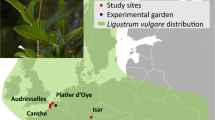Summary
In order to identify the genotypic constitutions of incompatibility in the diploid species, Ipomoea leucantha Jacq. (K221), which is most closely related to the sweet potato, the progenies derived from the reciprocal crosses, backcrosses and testcrosses were analysed. All the plants examined were self-incompatible, and pollen germination was inhibited on the stigma after incompatible pollinations. No reciprocal differences were found in the incompatibility reactions. In the progenies three incompatibility groups were observed which showed the rather simple segregation ratios. The homozygous plants for incompatibility alleles were obtained in the progenies. The experimental results demonstrated a sporophytic type of incompatibility controlled by a single locus with multiple S-alleles exhibiting a dominance relationship in both the pollen and the stigma. The plants obtained in the progenies had the following genotypes: S 1 S 2, S 1 S 3, S 2 S 2, S 2 S 3 and S 3 S 3.
Similar content being viewed by others
Literature
Austin, D.F. (1975): Convolvulaceae. In: Flora of Panama. Ann. Missouri Bot. Garden 62, 157–224
Austin, D.F. (1977): Hybrid polyploids in Ipomoea section batatas. J. Hered. 68, 259–260
Austin, D.F. (1978): The Ipomoea batatas complex. I: Taxonomy. Bull. Torrey Bot. Club 105, 114–129
Bateman, A.J. (1954): Self-incompatibility systems in Angiosperms. II. Iberis amara. Heredity 8, 305–332
Bateman, A.J. (1955): Self-incompatibility systems in Angiosperms. III. Cruciferae. Heredity 9, 53–68
Brewbaker, J.L. (1957): Pollen cytology and self-incompatibility systems in plants. J. Hered. 48, 271–277
Crowe, L.K. (1954): Incompatibility in Cosmos bipinnatus. Heredity 8, 1–11
Fujise, K. (1964): Studies on flowering, seeds setting, and self- and cross-incompatibility in the varieties of sweet potato. Bull. Kyushu Agr. Exp. Sta. (Japan) 9, 123–246
Gerstel, D.U. (1950): Self-incompatibility studies in guayule. II. Inheritance. Genetics 35, 482–505
Hernandez, T.P.; Miller, J.C. (1964): Further studies on incompatibility in the sweet potato. Proc. Amer. Soc. Hort. Sci. 85, 426–429
Hughes, M.B.; Babcock, E.B. (1950): Self-incompatibility in Crepis foetida (L.) subsp. rhoeadifolia (Bieb.) Schniz et Keller. Genetics 35, 570–588
Jones, A. (1968): Chromosome numbers in Ipomoea and related genera. J. Hered. 59, 99–102
Jones, A.; Deonier, M.T. (1965): Interspecific crosses among Ipomoea lacunosa, I. ramoni, I. trichocarpa, and I. triloba. Bot. Gaz. 126, 226–232
Knight, R.; Rogers, H.H. (1955): Incompatibility in Theobroma cacao. Heredity 9, 69–77
Magoon, M.L.; Krishnan, R.; Vijaya Bai, K. (1970): Cytological evidence on the origin of sweet potato. Theor. Appl. Genet. 40, 360–366
Martin, F.W. (1965): Incompatibility in the sweet potato, a review. Econ. Bot. 19, 406–415
Martin, F.W. (1968): The system of self-incompatibility in Ipomoea. J. Hered. 59, 263–267
Martin, F.W. (1970): Self- and interspecific incompatibility in the Convolvulaceae. Bot. Gaz. 131, 139–144
Martin, F.W.; Cabanillas, E. (1968): Classification of sweet potato varieties for incompatibility and sterility. Proc. Amer. Soc. Hort. Sci. 93, 502–511
Martin, F.W.; Jones, A. (1972): The species of Ipomoea closely related to the sweet potato. Econ. Bot. 26, 201–215
Martin, F.W.; Jones, A.; Ruberte, R.M. (1974): A wild Ipomoea species closely related to the sweet potato. Econ. Bot. 28, 287–292
Miyazaki, T.; Kobayashi, M. (1976): Studies on utilization of wild relatives in sweet potato breeding. I. Relationship between fertility and polyploidy of closely related species (abstract). Japan. J. Breed. 26 (Suppl. 1), 156–157
Miyazaki, T.; Sakamoto, S. (1974): Cross-incompatibility of sweet potato and related species (abstract). Japan. J. Breed. 24 (Suppl. 2), 208–209
Nishiyama, I. (1961): The origin of the sweet potato plant. Proc. 10th Pac. Sci. Congr., Honolulu, Hawaii, pp. 119–128
Nishiyama, I. (1971): Evolution and domestication of the sweet potato. Bot. Mag. 84, 377–387
Nishiyama, I.; Miyazaki, T.; Sakamoto, S. (1975): Evolutionary autoploidy in the sweet potato (Ipomoea batatas (L.) Lam.) and its progenitors. Euphytica 24, 197–208
Odland, M.L. (1962): The genetics of incompatibility in broccoli, Brassica oleraceae var. ‘italica’. Proc. Amer. Soc. Hort. Sci. 80, 387–400
Sampson, D.R. (1957): The genetics of self-incompatibility in the radish. J.Hered. 48, 26–29
Sampson, D.R. (1964): A one-locus self-incompatibility system in Raphanus raphanistrum. Can. J. Genet. Cytol. 6, 435–445
Sharma, A.K.; Datta, P.C. (1958): Cytological investigations on the genus Ipomoea and its importance in the study of phylogeny. Nucleus 1, 89–122
Shigemura, S. (1943): Cross-incompatibility groups in sweet potato and its simple test method. Ikushu Kenkyu (Tokyo) 2, 77–88
Shinjo, C.; Omura, T. (1962): Studies on the incompatibility in the sweet potato, Ipomoea batatas (L.) Lam. I. Classification of sweet potato varieties based on their cross-incompatibility. Japan. J. Breed. 12, 226–230
Teramura, T. (1979): Phylogenetic study of Ipomoea species in the section Batatas. Memor. College Agr. Kyoto Univ. No. 114, 29–48
Terao, H. (1934): Cross sterility groups in varieties of sweet potato. Agr. Hort. (Tokyo) 9, 1163–1167
Thompson, M.M. (1979): Genetics of incompatibility in Corylus avellana L. Theor. Appl. Genet. 54, 113–116
Ting, Y.C.; Kehr, A.E.; Miller, J.C. (1957): A cytological study of the sweet potato plant Ipomoea batatas (L.) Lam. and its related species. Amer. Naturalist 91, 197–203
Togari, Y.; Kawahara, U. (1942): Studies on the self- and cross-incompatibility in sweet potato. I. On the different grades of compatibility among the compatible matings. Bull. Imper. Agr. Exp. Sta. (Tokyo) 52, 1–19
Van Schreven, A.C. (1953): Investigations on the flower biology and compatibility of sweet potato (Ipomoea batatas Poir.) including some preliminary trials on the germination of the seed. Landbouw 25, 305–346
Wang, H. (1964): A study on the self- and cross-incompatibilities in the sweet potato in Taiwan (Formosa). Proc. Amer. Soc. Hort. Sci. 84, 424430
Wedderburn, M.M. (1967): A study of hybridization involving the sweet potato and related species. Euphytica 16, 69–75
Author information
Authors and Affiliations
Additional information
Communicated by K. Tsunewaki
Rights and permissions
About this article
Cite this article
Kowyama, Y., Shimano, N. & Kawase, T. Genetic analysis of incompatibility in the diploid Ipomoea species closely related to the sweet potato. Theoret. Appl. Genetics 58, 149–155 (1980). https://doi.org/10.1007/BF00263108
Received:
Accepted:
Issue Date:
DOI: https://doi.org/10.1007/BF00263108




